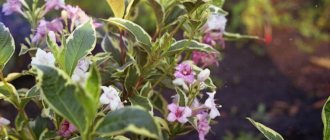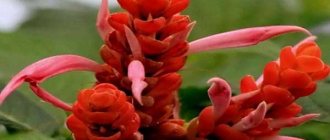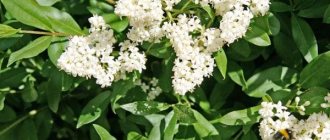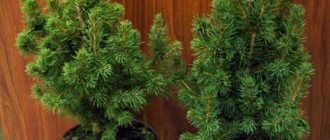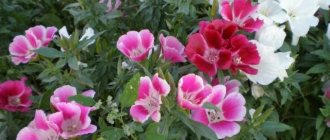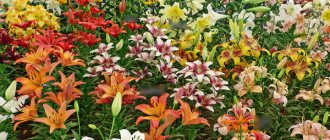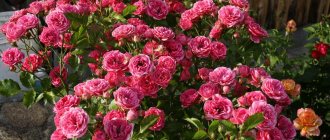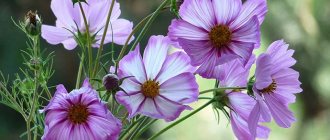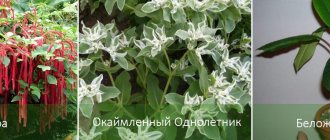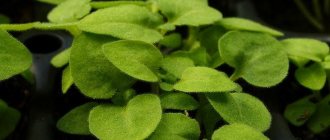Cordyline, according to information taken from various sources, is a representative of the Agave or Dracaena family. This genus includes about 20 different species. Under natural conditions, this plant can be found in all regions with tropical and subtropical climates. Cordyline is a tree or shrub. Thick and strong roots are white in cross section. The shape of the leaf blades depends on the type of plant and can be lanceolate, xiphoid or linear. As a rule, the flowers are painted white or red, less often purple. When growing cordyline at home, the bush usually has a height of no more than 150 centimeters. Over time, the lower leaf plates of the bush begin to die and fall off, as a result it takes on the appearance of a false palm. Gardeners cultivate cordyline because it has spectacular foliage.
Caring for cordilina at home
Illumination
Cordyline grown indoors needs bright sunlight, but it must be diffused. In this regard, it is best to place it near a window located in the western or eastern part of the room. Remember that the plant should be protected from direct sunlight. If the bush is a dark-leaved variety, then it does not need bright lighting.
Temperature
In the summer, in the room where the plant is located, the air temperature should be 20–25 degrees. When growing subtropical species, with the onset of autumn, the temperature should be gradually lowered, and in winter it needs a temperature of 5–10 degrees. If tropical species are grown, then in winter they need to be placed in a cooler place with a temperature of 18 to 20 degrees. Such plants need to be protected from drafts.
How to water

In spring and summer, this plant must be watered immediately after the top layer of the substrate dries. In winter, you should choose a watering regime so that the earth ball in the pot never completely dries out, but there is no need to over-moisten it. Those species that are at low temperatures in winter should be watered extremely carefully. For irrigation, use exclusively soft water that has been well settled for at least 24 hours.
Spraying
This plant should not be placed near heating appliances in winter. If subtropical species are grown, then they need to be moistened with a sprayer only from time to time. And tropical species in May–August are moistened with a spray bottle at least once a day. Cordyline should be moistened with soft and settled water. When spraying a bush, you need to be careful, as this can cause the growing points to rot.
Fertilizer
In spring, summer and autumn, the bush needs to be fed once a week with complex fertilizer. In winter, the plant is fed once every 4 weeks.
Transfer
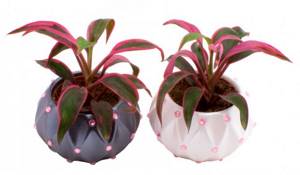
Young plants should be replanted once a year, and adult plants - once every 2 or 3 years. In the case when the roots no longer fit into the pot, the cordiline needs to be transplanted into a new larger container, which is carried out with the onset of spring. Before planting the bush, you need to make a good drainage layer at the bottom of the container, then it is filled with a slightly acidic soil mixture consisting of sand, garden soil and peat, which must be taken in a ratio of 1: 3: 1. This plant is suitable for growing hydroponically.
Cordyline home care / Cordyline
South Cordilina
Cordyline southern, or Australian, is a species of woody plants belonging to the genus Cordyline from the family Laxmanniaceae.
origin of name
Most likely, the name comes from the Greek “kordile”, which literally means a mace or club, obviously, this is due to the fact that during the growth process the plant trunk is deformed, thickening at the base, and is shaped like a mace.
Description of the plant
Cordyline can grow up to 15 m, has a tuberous root, so several plants can grow in close proximity to each other, forming a group similar to a bush growing from a single root. The Cordyline trunk is crowned with leaves that gather in a bunch, forming a dense crown. The leaves are long, up to 40-90 cm, with a width of 3-7 cm, hang arched, are bright green, sometimes with red or yellow stripes along the entire length of the leaf. During the flowering period, inflorescences appear in the form of dense panicles, on which are located flowers of a creamy white color, up to 1 cm in size and a bright fragrant aroma. After flowering, a fruit-berry is formed, white in color, not exceeding 5-7 mm. In appearance, Cordyline is similar to a palm tree, and Jem Cook dubbed this plant the cabbage tree, due to the fact that the aborigines eat the young leaves of Cordyline.
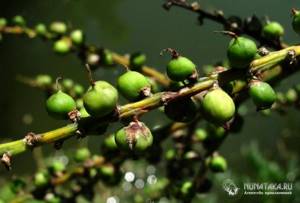
Cordilina. Fruit
Reproduction
Cordyline propagates in several ways - the top of an old tree is cut off and placed in water for 3 months, where it gives roots and then planted in the ground, it can also be propagated by stem cuttings, but this method is less effective.
Growing conditions
Southern Cordyline is an endemic plant of New Zealand, that is, it grew in a limited range of this area. Currently found in areas with a humid subtropical or tropical climate, both in natural growth and artificially planted trees. It is also popular among gardeners as a houseplant, in greenhouses and in open ground when creating gardens and parks. Optimal temperatures for full growth and development of the plant are 22-26oC in summer and not lower than 15-17oC in winter. Cordyline is a light-loving plant, but prefers semi-shaded places and the absence of direct sunlight. It loves an abundance of moisture, with foliar watering, that is, spraying the crown, but in winter it does not require abundant watering. It has taken root quite well in the climatic conditions of the Sochi Black Sea region, but in cold winters it requires protection from the cold by covering and mulching the soil.
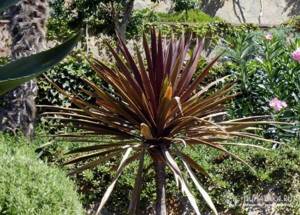
Artificially bred decorative variety “Red Sensation”
Application
Coarse wicker products, such as mats, brushes, and hard rugs, are made from raw materials extracted from dry Cordyline leaves, and the moisture resistance of the fiber allows it to be used as a tie for climbing plants, such as kiwi and grapes. Along with this, the seeds of the plant contain fatty oils with a high content of linoleic acid, up to 90%, which is a strong antioxidant and is used in the production of dietary supplements and in the cosmetics industry.
Interesting Facts
Cordyline can be eaten as it contains a large amount of carbohydrates, but not fresh, but after preliminary heat treatment. It was these properties of cardina that the indigenous people of New Zealand (Maori) used and for many centuries consumed it as food, not only in freshly prepared form, but also in a kind of “canned” form. Ancient tribes tied cordyline leaves into bundles and baked them in huge ovens (as archaeological studies have shown, these ovens were up to 7 m in length), then dried them in the sun and this “canned” product was stored for up to several years.
You can meet the southern cordelina by visiting the following programs:
My Sochi. Walking sightseeing tour of Sochi
A walk along the central streets of Sochi will introduce you not only to the history, architecture and ethnography of the resort, but will also immerse you in the green world of the city, revealing the secrets of introduction and the unique style of landscaping of the resort.
Order number: 013001
FIND OUT DETAILS
Sochi exclusive. Tour with botanical excursions
A rich tour program in Sochi lasting from 3 (three) to 7 (seven) days will introduce you inside and out to the nature of this unique place, rich floristic collections and natural landscapes of the resort.
Order number: 002102
FIND OUT DETAILS
Adler Arboretum. Excursion to the Southern Cultures Park
A charming tour of the Southern Cultures park will not leave you indifferent to the beauty of the landscapes, the complexity of the park forms, the splendor of small architectural elements and the rich collections of park vegetation. Along the alleys you can find rare and endangered species, including the beautiful Delaway magnolia.
Order number: 013020
FIND OUT DETAILS
Reproduction of cordyline
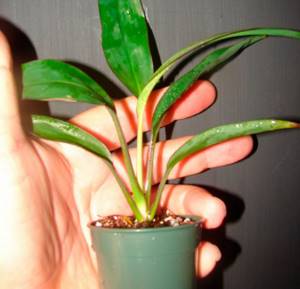
How to grow from seeds
The seed propagation method is suitable only for species plants. The fact is that when grown from seeds of varietal cordilines, they lose the varietal characteristics of the parent plants. The seeds are sown in the first half of March; for this purpose, a soil mixture consisting of turf soil and sand (1:1) is used. The appearance of seedlings occurs unevenly, the first of them appear after 4 weeks, and the last after 3 months.
Cordyline propagation by cuttings
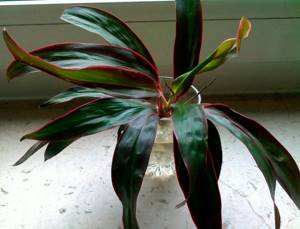
When cutting a cutting, you should take into account that there must be at least 1 node on it. For rooting, you can use apical cuttings, as well as parts of leafless shoots. However, it should be noted that the cutting must be semi-lignified. To root cuttings, you can use sand or a substrate consisting of peat soil, leaf or humus soil and sand (1: 1: 1). The cuttings must be regularly moistened with a spray bottle, and they must be placed in a warm place (25–30 degrees). If the cuttings are cared for correctly, then after about 4 weeks they can be planted in separate pots filled with a soil mixture consisting of humus, peat and turf soil, as well as sand (1: 1: 1: 1). For subsequent replanting, which is carried out by transshipment, a soil mixture is used, which includes compost or turf and humus soil, as well as sand (1:1:1).
Reproduction by division
If cordyline is propagated by dividing the rhizome, then all roots should be cut off from the division, and then it is planted in a substrate that is used for rooting cuttings. After the rhizome has roots again, it should be transplanted into the soil mixture used for planting adult specimens.
Cordilina. Cordyline propagation.
Reproduction
At home, cordyline reproduces by seed and vegetative methods. Seeds that appear on the plant do not retain their parental characteristics, so it is recommended to buy them in specialized stores. To plant seeds, you need to take the following steps:
- make a sand-peat mixture;
- moisten the mixture generously;
- sow the seeds, deepening them one centimeter;
- cover the soil with the seeds with film;
- wait for seedlings to appear (about two weeks);
- wait until four leaves appear;
- pick cordilina into pots of two or three pieces.
The second, more effective way is to separate the children from the root zone. To do this, it is necessary to cut off the young plant so as to capture part of the root. It is recommended to sprinkle the cut area with charcoal. Plant the young flower itself in fresh, fertile soil.
You can also propagate the plant by cuttings. To do this, it is necessary to cut off the semi-lignified stems, dividing them into several parts. You need to pay attention to the fact that there are two or three internodes in each section. The lower cut is immersed in the ground, having previously been treated with root. The recess should be between two and three centimeters. Then the pot with the plant must be covered with film and placed in a bright place, the air temperature should be from twenty-five to thirty degrees. It is recommended to ventilate the “greenhouse” daily and, if necessary, moisten it. The roots will finally strengthen in a month.
Diseases and pests
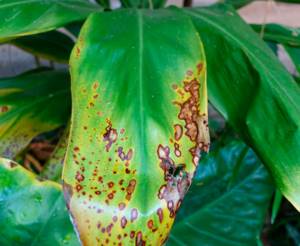
- Brown spots on the foliage - If brown spots appear on the leaf blades of Cordyline, this indicates that the plant does not have enough moisture.
- Leaf fall - Dying and falling of the lower leaf blades is a natural process for this plant, so you should not worry.
- Rotting of the bush - If there is stagnant moisture in the substrate, this can cause rot to appear on the lower part of the stem. In this case, it is recommended to trim the top of the bush, which is used for further rooting.
- Spots on leaf blades - If dry, light-colored spots appear on the foliage, this indicates that the plant has sunburn as a result of exposure to direct rays of the sun.
- Foliage curling - If the room is excessively cold, the cordyline foliage loses its turgor and curls.
- The tips of the leaf blades turn brown - If the tips and edges of the leaf blades turn brown, this means that the air humidity in the room is excessively low.
Cordyline pests
Spider mites, scale insects, whiteflies and mealybugs can harm such a flower.
Types of Cordyline with photos and names
Cordyline banksii

The height of the bush can vary from 150 to 300 cm. The straight trunk is quite thin. The leaf blades have long petioles, the length of which is from 15 to 30 centimeters. The upward-directed elongated lanceolate leaf plates are pointed towards the apex, they are about 150 centimeters long and about 8 centimeters wide. The front surface of the leaves is green, and the back surface is gray-green. The large paniculate inflorescence consists of white flowers. It is recommended to grow in a cool room.
Cordyline terminalis

Either Cordyline fruticosa or Dracaena terminalis. This shrub has a thin trunk. A bush may have several trunks. The length of the lanceolate leaf plates is about half a meter, and the width is about 10 centimeters; there are veins on the surface. They are colored green or have a variegated color (with a purple tint). The length of the petiole is about 15 centimeters.
Red Cordyline (Cordyline rubra).
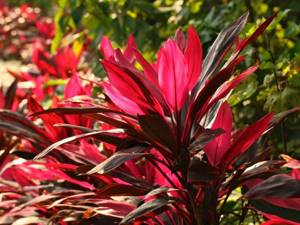
Or red dracaena (Dracaena rubra). The height of such a shrub is about four meters; as a rule, it is non-branching. Green lanceolate leaf plates, leathery to the touch, reach about half a meter in length and about 5 centimeters in width; there are veins on the surface. The length of the grooved petioles is about 15 centimeters. The axillary paniculate inflorescence consists of pale lilac flowers located on short pedicels. It is recommended to grow in a cool room.
Cordyline indivisa
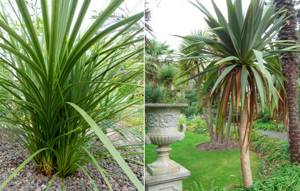
Or undivided dracaena (Dracaena indivisa). This plant is a tree reaching a height of 12 meters. The thin trunk does not bend because it is quite hard. The length of the belt-shaped sheet plates is about one and a half meters, and the width is approximately 15 centimeters. The central vein is red in color. The front surface of the foliage is matte green, and the back surface is pale gray. The branched drooping inflorescence consists of white flowers. Grows best in cool conditions.
Cordyline stricta
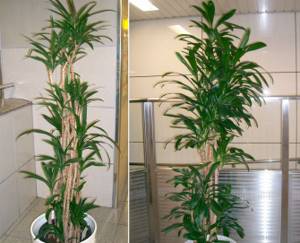
Either Dracaena congesta or Dracaena stricta. The height of the thin trunk is about 3 meters. The leaf blades, leathery to the touch, have a serrated edge and a green color; their shape is elongated-lanceolate, pointed at the apex. The leaves reach a little more than 50 centimeters in length, and their width is about 30 mm. The panicles consist of small lavender flowers. Inflorescences grow from the axils of the leaves and are also located at the top of the plant.
